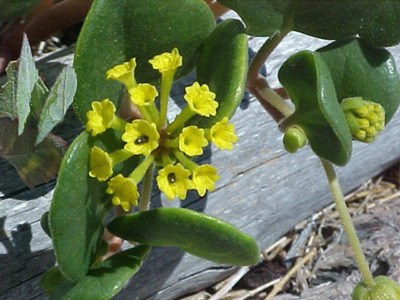Coastal sand dunes stabilized by silver bur sedge form one of the most rare and fragile habitats in the islands — indeed, in all of western Washington- — and one of the most scenic, with large balls of yellow sand verbena flowers that attract a variety of pollinators (and nectar eating but non-pollinating “cheaters”) that range from tiny beetles and ants to wasps and moths.
The aptly named sand verbena moth (Copablepharon fuscum), first identified at Deception State Park in 1995, feasts exclusively on this flower.
Small and brown, it is not much to look at, but few other butterflies or moths rely so completely on a single host species. Sand verbena moths fly and mate on summer evenings, drinking nectar from sand verbena flowers—and laying eggs on them as well.
The caterpillars hatch in mid-summer, hiding by day in the sand beneath their host plants and eating their way through the fleshy leaves at night until they are ready to pupate in the sand like cutworms.
Sand verbena moths have been red-listed in Canada, and are now being considered for possible listing as an endangered species in the United States.
As the sand warms in summer, another unusual insect makes its appearance: the “sand wasp,” actually a number of closely related species of a family of wasps called the Bembicini. Their life history is appropriately baroque. Each female wasp begins to dig her own short burrow and nest chamber in the sand as soon as she emerges.
She is soon mobbed as larger males form a “mating ball” around her, tugging and tussling until one of them succeeds in carrying her off a short distance and mounting her.
The female lays an egg in her burrow, then fills it with prey such as flies.
Some Bembicine species also feed on insects that try to eat or steal the prey cache.
In fall the eggs hatch into hungry larvae that thrive on the insects their mother cached.
Sand verbena moths eat sand verbena leaves and flowers, and sand wasps eat the flies and other small insects that compete with moths for sand verbena nectar.
One tiny “cheater” you may see in the dunes is a shiny black beetle the size of a rice grain.
Beetles in the Chrysomelid family are attracted to the sticky yellow flowers of sand verbena and stonecrops. Chrysomelid beetles are polyandrous: each female mates with many males and lays numerous clutches of eggs glued to the undersides of leaves — although some species carry and protect their eggs until they hatch.
A single female beetle may mate 50 times in her one to two-year lifetime, each time carrying the male around on her back for hours to days before he dismounts.
She completely controls the disposition of sperm, which she can use to fertilize a whole, or part of a clutch of eggs, or store for use the next spring, or discard.
It is not yet clear how female Chrysomelids decide which male beetles are more desirable fathers. Researchers believe it may have to do with a little dance the male performs whilst riding around on the female’s back.
Coastal dunes can be seen at Fisherman Bay Spit and along Agate Beach Road, but is very important not to walk on them.
Walking over a dune can be enough to break up the bur sedge root ball, and the dune will begin to crumble away.




